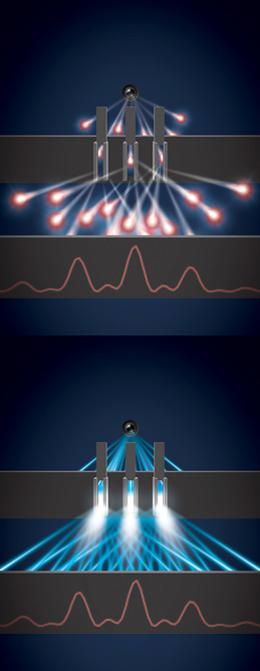Layers of Earth's upper atmosphere. Credit: John Emmert/NRL.
"This is the biggest contraction of the thermosphere in at least 43 years," says John Emmert of the Naval Research Lab, lead author of a paper announcing the finding in the June 19th issue of the
Geophysical Research Letters (GRL). "It's a Space Age record."
The collapse happened during the deep
solar minimum of 2008-2009—a fact which comes as little surprise to researchers. The thermosphere always cools and contracts when
solar activity is low. In this case, however, the magnitude of the collapse was two to three times greater than low solar activity could explain.
"Something is going on that we do not understand," says Emmert.
The thermosphere ranges in altitude from 90 km to 600+ km. It is a realm of
meteors, auroras and satellites, which skim through the thermosphere as they circle Earth. It is also where solar radiation makes first contact with our planet. The thermosphere intercepts extreme ultraviolet (EUV)
photons from the sun before they can reach the ground. When solar activity is high, solar EUV warms the thermosphere, causing it to puff up like a marshmallow held over a camp fire. (This heating can raise temperatures as high as 1400 K—hence the name thermosphere.) When solar activity is low, the opposite happens.
Lately, solar activity has been very low. In 2008 and 2009, the sun plunged into a century-class solar minimum.
Sunspots were scarce, solar flares almost non-existent, and solar EUV radiation was at a low ebb. Researchers immediately turned their attention to the thermosphere to see what would happen.

Enlarge
These plots show how the density of the thermosphere (at a fiducial height of 400 km) has waxed and waned during the past four solar cycles. Frames (a) and (b) are density; frame (b) is the sun's radio intensity at a wavelength of 10.7 cm, a key indicator of solar activity. Note the yellow circled region. In 2008 and 2009, the density of the thermosphere was 28% lower than expectations set by previous solar minima. Credit: Emmert et al. (2010), Geophys. Res. Lett., 37, L12102.
How do you know what's happening all the way up in the thermosphere?
Emmert uses a clever technique: Because satellites feel aerodynamic drag when they move through the thermosphere, it is possible to monitor conditions there by watching satellites decay. He analyzed the decay rates of more than 5000 satellites ranging in altitude between 200 and 600 km and ranging in time between 1967 and 2010. This provided a unique space-time sampling of thermospheric density, temperature, and pressure covering almost the entire Space Age. In this way he discovered that the thermospheric collapse of 2008-2009 was not only bigger than any previous collapse, but also bigger than the sun alone could explain.
One possible explanation is carbon dioxide (CO
2).
When carbon dioxide gets into the thermosphere, it acts as a coolant, shedding heat via infrared radiation. It is widely-known that CO2 levels have been increasing in Earth's atmosphere. Extra CO2 in the thermosphere could have magnified the cooling action of solar minimum.
"But the numbers don't quite add up," says Emmert. "Even when we take CO2 into account using our best understanding of how it operates as a coolant, we cannot fully explain the thermosphere's collapse."

















